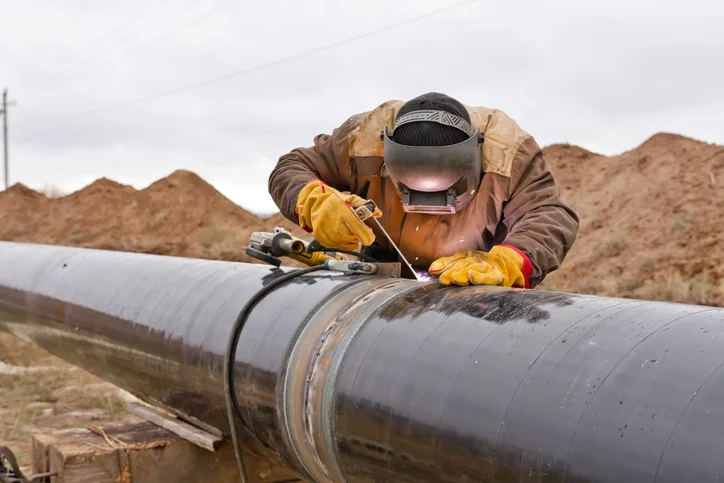Maximize Performance: Proactive Pipeline Welding Inspection Techniques
Maximize Performance: Proactive Pipeline Welding Inspection Techniques
Blog Article
Comprehensive Review of Pipeline Welding Evaluation Treatments
Pipe welding evaluation treatments play a crucial duty in ensuring that bonded connections satisfy strict industry criteria and specs. From careful pre-welding assessments to extensive post-weld assessments, a distinct inspection procedure is essential for keeping the structural soundness of pipes.
Pre-welding Examination Preparations
Prior to commencing the welding procedure, extensive pre-welding inspection preparations are important to make certain the stability and quality of the weld joint. These prep work involve a precise examination of the products to be bonded, the welding devices, and the job atmosphere. To start with, the materials have to be examined for any kind of problems, contaminants, or inconsistencies that can jeopardize the weld. This includes checking for appropriate material qualities, dimensions, and surface area problems. Pipeline Welding Inspection. Additionally, the welding equipment needs to be inspected to confirm that it is in great functioning condition, adjusted correctly, and appropriate for the certain welding procedure. Any kind of issues with the devices need to be dealt with without delay to stop defects in the weld. Finally, the workplace have to be assessed for tidiness, appropriate ventilation, and security steps to ensure a conducive setting for the welding procedure. By conducting extensive pre-welding evaluation preparations, potential issues can be identified and dealt with at an early stage, bring about high-grade and reliable weld joints.
Welding Procedure Credentials
Complete pre-welding assessment preparations lay the structure for the crucial procedure of Welding Procedure Qualification, making sure the integrity and top quality of the weld joint. Welding Procedure Qualification (WPQ) is a vital action in the welding procedure that entails testing and certifying welding treatments to guarantee they satisfy specific requirements and needs. The WPQ process generally consists of welding procedure spec advancement, welding treatment certification screening, and documentation of the results.
Throughout welding procedure spec growth, important information such as the welding procedure, welding products, joint design, and welding specifications are specified to create a detailed treatment. Ultimately, welding procedure certification screening is conducted to validate the suggested treatment's stability. This screening often involves welding test vouchers that go through numerous mechanical and non-destructive tests to evaluate the weld's high quality and adherence to the defined requirements.
In-process Weld Evaluation
Throughout the welding procedure, in-process weld examination plays an important function in making certain the quality and integrity of the weld joint - Pipeline Welding Inspection. This type of assessment entails keeping track of the welding criteria, assessing the weld bead formation, and spotting any type of prospective problems or discontinuities as they happen. By performing in-process weld inspections, welding operators can quickly attend to any type of problems that may occur, thus preventing further defects and ensuring that the go to this site final weld satisfies the required requirements
Usual approaches made use of for in-process weld inspection consist of visual examination, fluid penetrant screening, magnetic fragment screening, ultrasonic testing, and radiographic testing. Overall, in-process weld inspection is crucial for maintaining the quality and integrity of bonded pipelines.
Non-destructive Screening (NDT)
Non-destructive Screening (NDT) is a crucial approach utilized in pipeline welding assessment to my review here analyze the integrity of weld joints without causing damage to the bonded structure. By utilizing numerous NDT methods, inspectors can assess the high quality of welds and determine any type of flaws or stoppages that might compromise the structural sturdiness of the pipe. Common NDT methods made use of in pipeline welding evaluation include Radiographic Testing (RT), Ultrasonic Screening (UT), Magnetic Particle Checking (MPT), Liquid Penetrant Screening (LPT), and Visual Testing (VT)
RT entails the use of X-rays or gamma rays to create photos of the internal structure of the weld, permitting inspectors to discover defects such as porosity, fractures, or incomplete combination. In addition, VT includes visual inspection of welds to determine any kind of visible blemishes.
Post-weld Inspection and Documentation


Documents of post-weld evaluation findings is necessary for maintaining quality assurance documents and making certain compliance with sector standards and laws. Comprehensive records ought to consist of info concerning the examination methods made use of, the area and nature of any kind of flaws found, and any corrective activities taken - Pipeline Welding Inspection. Correct documents not only acts as a document of the weld's top quality however likewise help in future upkeep and inspection processes
Final Thought

In verdict, pipe welding examination procedures play an important function in guaranteeing the high quality and integrity of welds. In general, adherence to correct examination procedures is key to the success of pipe welding projects.
From thorough pre-welding assessments to thorough post-weld analyses, a distinct evaluation procedure is essential for maintaining the structural soundness of pipes. By carrying out in-process weld assessments, welding drivers can quickly resolve any kind of issues that may emerge, thereby avoiding additional defects and ensuring that the final weld fulfills the called for specs.
Typical approaches used for in-process weld evaluation include aesthetic inspection, liquid penetrant screening, magnetic bit testing, ultrasonic testing, and radiographic testing.Non-destructive Screening (NDT) is an important method used in pipeline welding inspection to assess the integrity of weld joints without triggering damages to the welded structure. Post-weld inspection includes numerous approaches to examine the welds for problems, consisting of aesthetic assessment, dye penetrant screening, magnetic bit testing, ultrasonic testing, and radiographic testing.
Report this page